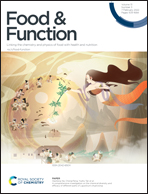Inhibitory effects of a low-molecular-weight sulfated fucose-containing saccharide on α-amylase and α-glucosidase prepared from ascophyllan
Abstract
To find natural and safe anti-diabetic foods or potential drugs, low-molecular-weight saccharide fragments LMWAs-H (Mw 33.48 kDa) and LMWAs-L (Mw 6.71 kDa) from the sulfated polysaccharide ascophyllan of Ascophyllum nodosum using alginate lyase (EC 4.2.2.3) were investigated. The results revealed that LMWAs-H possessed potent inhibition activity against α-glucosidase or α-amylase in a concentration-dependent manner, which were higher than native ascophyllan or LMWAs-L. LMWAs-H exhibited a stronger inhibitory activity against α-glucosidase than α-amylase because it differently affects the conformational structures of these enzymes. Structural analysis revealed LMWAs-H to be →4)-α-L-Fucp-(1 → 4)-α-L-Fucp-(1 → 3)-β-D-Xylp-(1 → 3)-α-L-Fucp4S(1→ as main chain, and T-α-D-Glcp-(1→ and →3)-β-D-ManpAred residues were attached to the ends of main chain as non-reducing- and reducing-end residues, respectively. The 4-deoxy-L-erythro-hex-4-enuronosyluronate linked the O-4 position of →3,4)-β-D-ManpAred residue as side branches. Our results suggest that LMWAs-H is the main active structural motif responsible for the enzymes-inhibiting activities, which is probably derived from the fucose-containing branches of ascophyllan. Our findings reveal that the strong inhibition of LMWAs-H on α-glucosidase but mild inhibition on α-amylase is highly related to its structural properties, suggesting its desirable characteristics as an anti-diabetic agent.

- This article is part of the themed collection: Food & Function HOT Articles 2022


 Please wait while we load your content...
Please wait while we load your content...